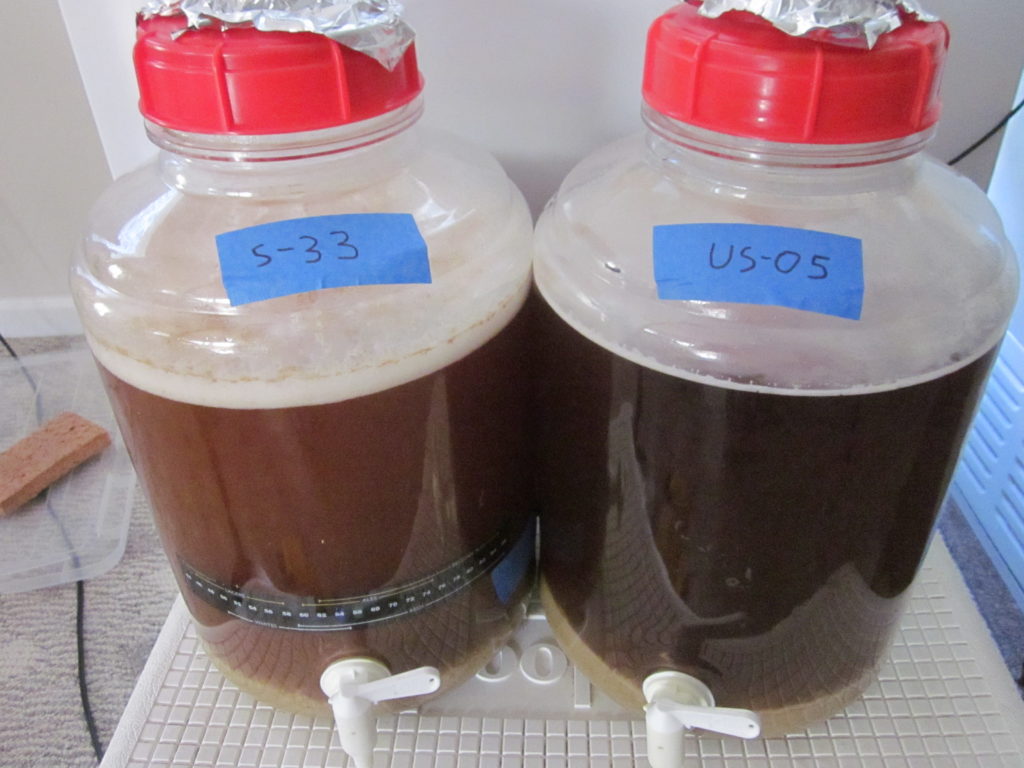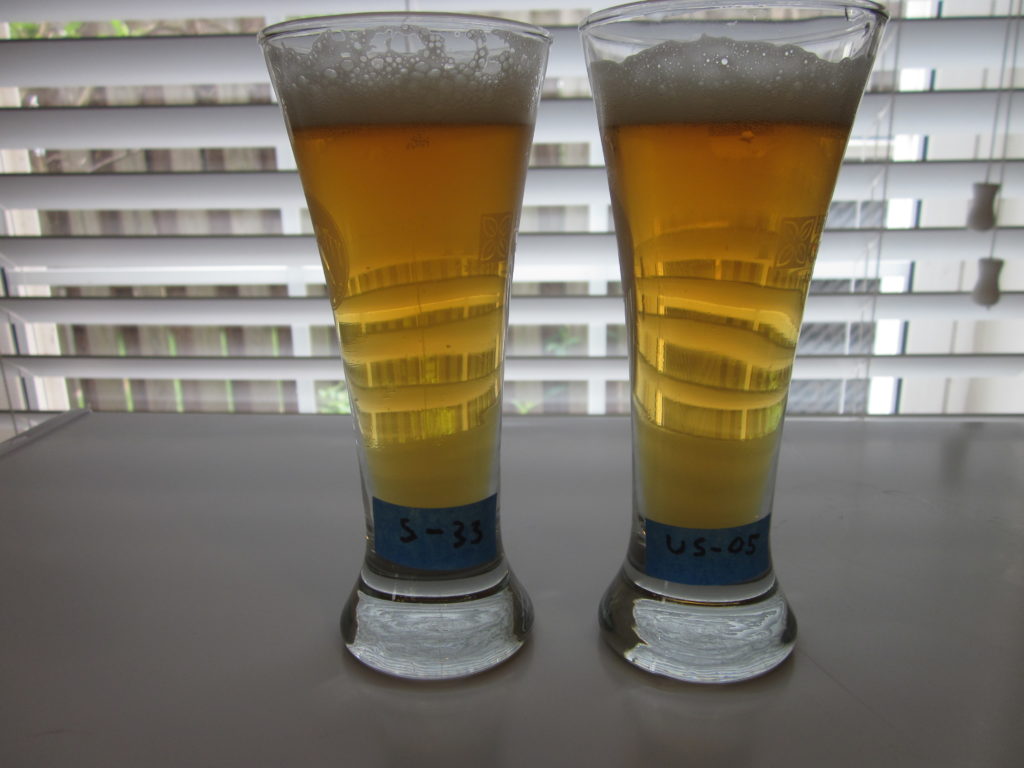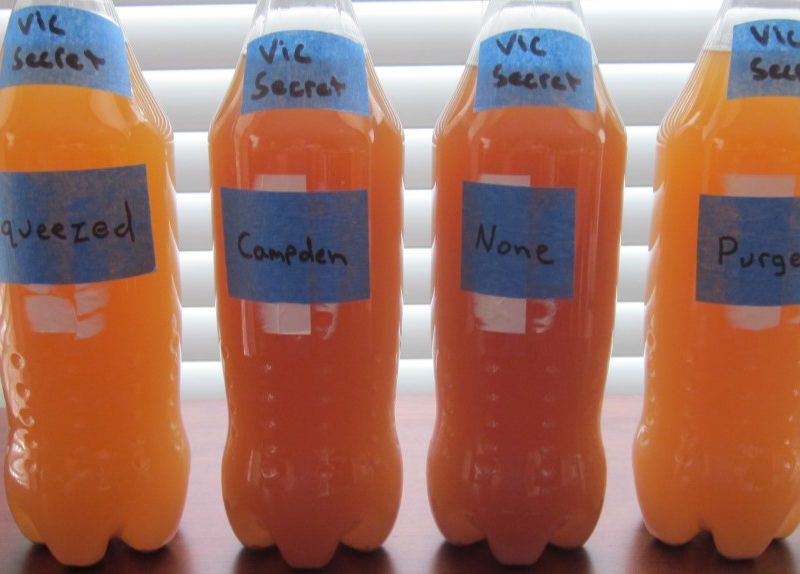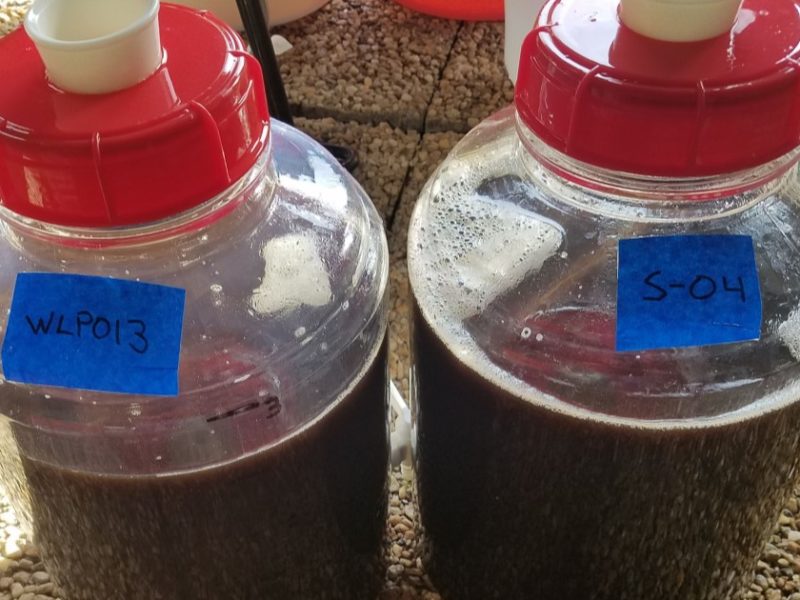I put my split yeast investigative brewing process to the test to evaluate two dry yeasts. Read along for my yeast Evaluation of US-05 vs S-33 in an American Pale Ale made with Murphy & Rude malts and Amarillo hops.
Yeast Evaluation Video
If you are a visual kind of person, I put together a video. The video captures some footage of brew day, some thoughts on the brew and my goals, as well as a tasting of the two beers.
Yeast Selection…Why US-05 and S-33?
There was not anything too deep into the yeast selection here. I have a number of dry yeasts that I would like to evaluate for usage in a beer like an American Pale Ale, American IPA, Hazy Pale Ale or NEIPA. While I have mostly used liquid versions of the Chico strain, US-05 as my control yeast seemed like a good choice. I read a recommendation for S-33 in Pale Ale and IPA beers, and I had recently picked up a pack.
Note that the Fermentis description of S-33 is rather odd.
General purpose ale yeast with neutral flavor profiles. Its low attenuation gives beers with a very good length on the palate. Particularly recommended for specialty ales and trappist type beers. Yeast with a medium sedimentation: forms no clumps but a powdery haze when resuspended in the beer.
Research says this is a non-phenolic English origin strain sold by other vendors as an English ESB yeast. Forum posts of brewers using S-33 for Trappist beers usually include tales of disappointment.
Goals and Learning New Things
The primary goal of this investigative batch was to evaluate yeasts for use in an American Pale Ale, or potentially similar styles of beer. In addition, this investigative batch also highlighted several other educational opportunities.
- Malts from Murphy & Rude: I recently picked up a number of malts made by Murphy & Rude Malting in Charlottesville Virginia. This batch was 100% Murphy & Rude malts.
- Revisit Amarillo hops: I used to love Amarillo, but some recent batches I have made with Amarillo tended to lean too much toward orange pith. A Pale Ale made with Amarillo would give me a chance to reevaluate Amarillo.
- Learning about Dry Yeasts: When I started brewing, liquid yeasts were regarded as higher quality than liquid. Over the years, the quality of dried yeast has steadily improved. While there is still more variety in liquid yeast, more dry yeasts are released every year. Dry yeasts have several appealing qualities including lower cost, longer storage life, and less need for a starter. I would like to evaluate brewing more with dry yeasts.
- Evaluate Pale Ale Recipe: I have brewed a very similar beer many times over the years. That said, I have only brewed a couple Pale Ale batches since I made several process improvements in 2019 (such as water chemistry and fermentation temperature control). My tastes have also continued to evolve.
- Hop Steep (Whirlpool) vs Dry Hop: While I have used flameout hops for many years, and I would often let them sit for 5 minutes or so before cooling, the idea of an extended steep/whirlpool is fairly new to me. The same applies to adding hops at a lower temperature. I recently brewed a batch of a Pale Ale where I shifted the planned dry hop addition to a 20-minute steep with the hops added at 170F. I was very happy with how that batch turned out, so I wanted to evaluate that approach again.
- Refractometer for Gravity: Spoiler, it failed. I have been wanted to use my refractometer more for gravity readings during or after fermentation. The small sample needed for refractometer readings is especially useful for small batches. When my final gravity readings with my refractometer did not seem right, I realized my refractometer calibration was off. I will cycle back to this in the future.
- 30-minute Boil: I have brewed several batches of Pale Ale or IPA using a 30-minute boil. This means a slightly larger hop addition at 30 minutes vs 60 minutes to hit the same IBUs. I figured this would be one more datapoint in my evaluation of 30-minute boils.
I am often amazed at how much there is to learn with every batch, even from a one of my most brewed styles, the simple Pale Ale.
Recipe for 5 Gallons
I decided on a simple Pale Ale recipe for this batch. This is very similar to what I would call my “house” Pale Ale recipe which at one point was based on either Deschutes Mirror Pond or Sierra Nevada Pale Ale. Over the years I have added a little more hops and reduced the amount and color of the Crystal. This was a 5-gallon batch.
- 10 lbs (4.5 kg) – 97% – Murphy & Rude American Pale
- 12 oz (340 g) – 7% – Murphy & Rude Crystal 40
- 0.4 oz (11g) Columbus at 30 for 18 IBUs
- 1 oz (28g) Amarillo at 10 min
- 1 oz (28g) Amarillo at Flameout
- 2 oz (57g) Amarillo in Whirlpool at 170F (drop to 160F?)
- Split with US-05 and S-33, half a pack into each
- Adjusted water to boost Sulfate to ~200 and pH to ~5.4
- 153F (67C) target mash temp (actual started 154F to 152F)
- Start ferment at 65F (18C), boost to 72F (22C) as fermentation started to slow
- Closed transfer into 2.5-gallon (10L) Torpedo kegs on day 13
The target OG was 1.052, but the beer came in at 1.058. I am not sure if this is a result of the Murphy & Rude malt used. I had issues with crushing the rather plump grain kernels, so I ended up milling the grain twice. The first pass was at a wide setting and the second was at my standard setting. This may have contributed to the efficiency boost.
Compare US-05 vs S-33
Finally, I am at the point of comparing the two yeasts!
Fermentation
The S-33 batch started faster and fermented faster. I saw some minor signs of fermentation activity 8 hours after pitch and fermentation started to slow after about 3 days. While the US-05 started a little slower, it was showing signs of active fermentation the following morning. I would call the US-05 fermentation pretty typical for my Chico yeast experience. Fermentation started to slow after about 5 days. Both yeasts were done in about a week, and were given another week to finish up and settle. I did not cold crash either batch.
| US-05 | S-33 | |
| OG | 1.058 | 1.058 |
| FG | 1.012 | 1.018 |
| ABV | 6.1% | 5.3% |
| Attenuation | 78% | 68% |

Appearance
This recipe produced a wonderful medium gold colored beer. Process changes to limit oxygen exposure of hoppy beers, even lightly hopped beers like this Pale Ale, has lightened the color. After two weeks in the keg, the S-33 batch was till holding on to a slight powdery haze, where the US-05 batch had dropped clear. At the 3-week mark, the S-33 beer had caught up and was equally clear. Both batches had a similar white head with excellent head retention.

Aroma
Of the split yeast investigative batches I have done, this one produced the most distinct results. It started with the aroma. The US-05 batch had limited yeast character that let the aroma of the malt and hops shine through. On the other hand, the S-33 beer had a distinct aroma. At first I thought it was a bit like a rubber aroma, but I feel like a dried apricot descriptor fit better. That label also made the character seem more appealing!
As far as the base beer goes, the hop character from the Amarillo hops was present but not overpowering. Orange and citrus character dominated. I have been happy with the hop character I have been getting with a 20-minute hop steep, though not so much about adding a 20 minute step to my brew day.
Flavor
Both of these batches reminded how this simple base recipe has become my house Pale Ale recipe and my most brewed beer of all time. Adding in the hop stand may have pushed the bitterness level a touch higher than ideal, but it was not out of line.
The flavor of the two batches lined up with the aroma. The S-33 batch added some fruity notes that leaned toward apricot to my pallet. Feedback from others lined up with the fruity character, but others did not describe it as apricot. I have brewed so many beers with the Chico yeast that it can be hard for me to pick out exactly what it adds. In my mind, Chico yeast adds just a touch of a clean ale character with and leaves a medium-light body. If the US-05 added different character than WLP001 or WY1056, I did not pick it out.
Mouthfeel and Digestibility
This is another area where the two batches differed. Even with trying to put aside my bias of knowing the final gravity of each batch, the S-33 batch had a more mouthfeel. The US-05 had a medium mouthfeel. I felt it was more noticeable digestibility or drinkability of the two. After drinking a full pint of the S-33 beer, I felt a bit full. After a pint of the US-05 batch I wanted another.
Overall Thoughts on US-05 vs S-33
I really liked the US-05 version of this beer. While I don’t know if US-05 produces the exact same beer as WLP001 or WY1056, this version had the clean but flavorful character that I expect from a Chico/California Ale yeast. While there is some yeast character, the yeast got out of the way and let the grain and hops take center stage. The US-05 was an easy drinking beer with lots of character and hop flavors. While I want to evaluate more yeasts for use in Pale Ales and IPAs, and I want to closer look at US-05 vs the liquid versions, I could see US-05 being a staple yeast in my brewery.
I liked the S-33 version, just not as much as the US-05. If I did not have the two versions, I would have been happy with this beer. I am not sure how much biases from knowing the low attenuation impacted me, but drinking a full pint of this beer seemed rather filling. The apricot aroma and flavor stood out a bit to me. That said, preference by several of my brewer friends was split with maybe a little more preference for the S-33 version. If you are looking to add a unique spin on your Pale Ales, S-33 might be the answer.
I could easily see tuning a recipe around the characteristics of S-33. Using a lower mash temperature would boost the ABV and maybe make the beer easier to drink. Swapping out the Crystal for Munich Malt might lower the sweetness. I could see S-33 working well in a NEIPA style beer. My prior attempt at a 5% Hazy Pale Ale was mostly a failure due to an overly thin body. I could see S-33 being a good fit for this style. I will keep S-33 in mind moving forward and play around with it in a few other styles.
Thoughts on “New Things”
Earlier I mentioned that there ware other educational opportunities of this batch.
- Malts from Murphy & Rude: While it is hard to pick out specific malt character with this batch, I have been very happy with my two batches made with Murphy & Rude malts. This really was an excellent beer and I have been very pleased with Murphy & Rude so far. Check them out here.
- Revisit Amarillo: I am open to using Amarillo in the future. I might try just using Amarillo as whirlpool and dry hops to avoid some of the pith character. I should also try out Amarillo from a different supplier or from a different crop year. My current thoughts are that there are better hops for adding citrus or fruit flavors, but I have had some excellent beers made with Amarillo.
- Learning about Dry Yeasts: Both of these dry yeasts produced very good beers and they were very easy to use. I will continue to use more dry yeasts. The idea of using mostly dry yeasts and skipping starters and harvesting yeast is appealing.
- Evaluate Pale Ale Recipe: I am very happy with the core recipe. I feel that around 8% of a Crystal 40 makes a great beer. The water chemistry was spot on. I might pull back the bitterness a touch if I keep the 20-minute Hop Steep.
- Hop Steep (Whirlpool) vs Dry Hop: Again, I was very happy with the hop quality of this batch. Both the aroma and the flavor. I would like to do a split investigative batch to evaluate a dry hop vs hop steep version.
- 30-minute Boil: I will continue to use 30-minute boils for my hoppy beers and will evaluate 30-minute boils for other styles.
Next Steps
I have a bunch of yeasts that I want to try out! As I try to move into using more dry yeasts, I want to try out more dry yeasts for my favorite styles and recipes: Porters, Stouts, Trappists, Saisons, NEIPAs, Pale Ales, and IPAs. I want to try S-33 in a Hazy Pale Ale or an NEIPA along with Verdant. I have brewed a few batches with Omega Voss and I picked up some packs of Lallemond’s dry Voss. There are plenty of other Kveik yeasts that I want to try out. For the most part, anytime I am brewing a 5-gallon batch and my smaller fermenters and kegs are open, I will look to use two yeasts. I hope to brew more 1-gallon batches moving forward as well.
Be sure to check back if this type of investigative batch is of interest to you. Let me know if you have some yeasts you would like me to trial.



